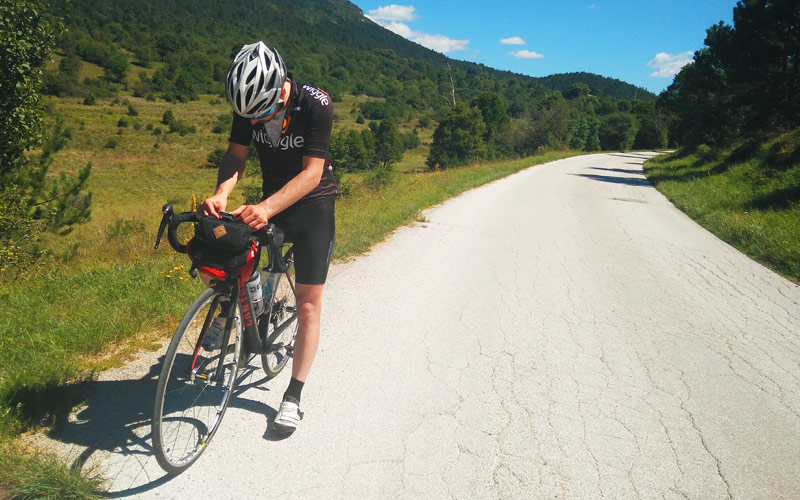Choosing a model within the range of bike helmet is a particularly sensitive issue, given that it is the most important safety element . The world of the bicycle is riddled with marketing.And terminology that often misleads us when choosing the most suitable bicycle components or accessories.
If we add that when choosing a bike helmet we must take into account aspects such as aerodynamics. Ventilation or comfort, things get even more complicated.
In this article we want to shed light on the matter. Expose what are the aspects that you must take into account to help you when buying the bike helmet that best suits your needs.
Factors to consider when choosing a bicycle helmet:

Measurements of the bicycle helmet
You may have noticed that most brands use “SML” type terminology to describe helmet size . Actually each of these terms frames some measurements in centimeters.
For example the Catlike Mixino is divided into:
- SM: Between 52 and 54 centimeters
- MD: Between 55 and 57 centimeters
- LG: Between 58 and 60 centimeters
How to know the size of our bike helmet?

We simply have to measure the circumference of our skull at the height of the forehead. Just above the eyebrows, that is the position in which we must place the helmet ..
The same helmet size can be used for different measurements. So when putting on the helmet we should adjust it with the rear wheel. If you need very little adjustment, we should try a larger or smaller size.
It is important to keep in mind that the helmet must be subject but never squeeze, as this can cause headaches.
Safety of bicycle helmets
As we have said before, the helmet is the element of security par excellence in cycling. Buy a bike helmet in the European Union requires that it has gone through a series of homogenization and certifications.
More specifically, any cycling helmet sold in community territory must be certified to the European Directive 89/686 / EEC , this approval is achieved thanks to the EN1078 certification.
What should I look to make sure a helmet is safe?
EN 1078 is the code you should look for in the packaging of the helmet along with the CE symbol to ensure that the helmet meets European standards.
Similarly, the United States and Australia have their own certification bodies with their own safety approvals. And certifications according to their own standards. Any brand that wants to sell a cycling helmet there must pass the tests , usually most do it and it is normal to find the logos of the CPSC.
Although these are not mandatory in Spain, they can give us a clue that the helmet we are going to buy has gone through more tests and its safety is more accredited.
Bicycle helmet models there are many How to know if they are safe?
If all are safe, why is there such a difference in the price of a helmet?
The standards guarantee a minimum of security, from there brands can manufacture helmets with more innovations to protect our heads.
One aspect to consider is the construction of the helmet, generally the road cycling helmets and MTB are made with polystyrene for the inner part and polypropylene in the outer shell. In low-end helmets these two parts are manufactured separately. And then stick, while in the highest quality helmets are manufactured in a single mold formed a single piece, being more efficient when absorbing impacts, this is called construction “In-mold”.
This type of construction makes the product more expensive. As well as using lighter and more resistant materials such as Graphene. Integrating a retention system designed to maximize the absorption of MIPS impacts. Or simply because of the lightness of the whole.
The black elastics make up a second layer of impact protection in the MIPS system of Giro helmets
Ventilation of a bike helmet
This is one of the key points when choosing a bike helmet. We are going to use it for hours and in the course of intense. Or even strenuous physical activity. That is why we must take into account the ventilation, and therefore refrigeration, that the helmet that we choose will provide us.
How to know if a helmet is breathing well?
We can be guided by the number of ventilation holes. This can be a clue to the amount of air that will “enter” in our head. Now, it is not about quantity but quality. Since the most important thing is to know if the helmet integrates a good air conduction that circulates inside it.
A trick to determine if a bike helmet has a good ventilation system is to face it. Putting the helmet between a wall of color and us. If looking at it we can see through the holes the color of the wall means that the air has well-designed holes for both entering and leaving , thus ensuring a correct flow of wind.
Comfort of cycling helmets
Comfort is something very personal and subjective, a helmet that for someone is comfortable can be uncomfortable for another person, both the shape of the head and the fact that we have a lot or little hair in it.
In any case to know if a helmet is comfortable there are a number of aspects that you should look to orientate yourself:
How to know if a helmet is comfortable?

According to the helmet padding
- This must be arranged along all the points of contact of our head with the shell of the helmet.
- It must be made of a soft material with a certain degree of sponginess , so that under conditions of high movement or heat, it is not abrasive and properly dampens the movements of our head
- There are helmets that integrate pads with more comfortable gel inserts and others made with antibacterial and sweat-wicking fabrics
- The Spiuk Nexion is one of the most comfortable cycling helmets thanks to its abundant and enveloping padding
According to the fastening of the helmet
- The restraint system is located on the occipital part, above the nape of the neck , and will extend through the lateral and superior part of the head
- Some clamping systems allow several positions in height , to accommodate different head sizes
- Currently most helmets integrate the wheel system to make the ideal fit, we should look for it as the most successful, especially those in which the wheel has an adjustment as millimeter as possible
- When adjusting the helmet this system should keep the helmet firm on the site , just above the eyebrows, but without being tight
- The clamping strips must allow to adjust the height of the same , so that they do not bother us in the ears or tighten us, and in addition they must be made of a soft material that does not scratch.
According to your accessories

- The visor is an element traditionally used in the practice of MTB XC, currently in disuse. But for some it may be useful when it comes to protecting the eyes from the sun
- There are models that incorporate the possibility of removing and putting the visor
- The anti-insect nets ensure that if a flying insect enters the holes of our hull, it does not get in the head or can bite us
- Not all helmets make it up
- The chinrest is intended to prevent the clip of the fastening strips from being annoying
- Depending on the helmet it will integrate or not, it is not essential and you can roll comfortable without them.
Use of the cycling helmet
Depending on the type of cycling that we want to practice there are different types of bicycle helmet. These will adapt to the particularities of each discipline, either in terms of protection, ventilation or aerodynamics.



